Mochi Pounding for the New Year
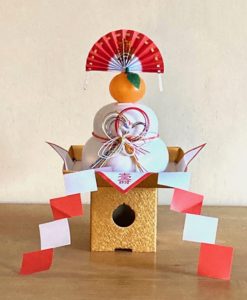
Formerly, kagami-biraki occurred on the 20th day after New Year, but was moved to the 11th, because of the death of Tokugawa Iemitsu on April 20th. Thus, some occasions were avoided on the 20th of every month. For the Lunar New Year, kagami-mochi is offered and broken open 20 days later, which corresponds with Lunar Ko-shō-gatsu, 小正月, Little-correct-month, which occurs on February 10, 2023.
Mochi is eaten throughout the year in Japan. Mochi is made at home and professionally. Making mochi is called mochi-tsuki, 餅搗き, mochi-pound. The word mochi-tsuki is also written with the Kanji, 望月, full moon-month. In general, making mochi is steaming mochi–kome, 餅米, mochi-rice, called sweet rice and glutinous rice. After it is cooked, the rice is put into an usu, 臼, mortar. The usu may be made of wood or stone. While still hot, the rice is pounded with a large wooden mallet called a kine, 杵, and turned by hand, and pounded until a single, smooth, rubbery mass. Portions of the mochi are formed into spheres of different sizes, and eaten or let to cool.
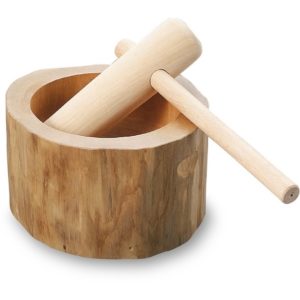
According to old traditions, the mochi in various forms is given to teachers, shrines, and others, and as offerings to deities. Special displays called kagami mochi, 鏡餅, mirror mochi, are presented on Koto-hajime, 事始め, Matter-begin, and Shō-gatsu Koto-hajime, 正月事始め, Right-month Matter-begin, as preparations for the New Year. Although the date varies, at present, Koto-hajime is December 8th. For some sources, the date is the 13th day of the 12th lunar month. There is also the tradition of having the event on the first day of the Oni, 鬼, Demon, of the lunar 12th month. Perhaps because this confluence rarely happens, the dates vary. The Buddhist guardian of the 13th day of the month is Ko-kū-zō Bo-satsu, 虚空蔵菩薩, Empty-void-keep Grass-buddha; the en-nichi, 縁日, edge-day, of Kokūzō is the 13th day of every month.
Kokūzō is the guardian of the northeast, and may be represented by the shō-kyaku, 正客, in the Tearoom. It should be remembered that the northeast direction is called the Ki-mon, 鬼門, Demon-gate, and the day of Koto-hajime was held on the day marked by the sign of the Oni, 鬼, Demon. The ‘demon’ is, despite identification, not evil, but powerful. So powerful that it may cause damage, such as storm winds, which are greatly identified with the northeast winds; the nor’easter. The Oni may be the guardian of the northeast, and not a manifestation of the ‘evil’ winds from the northeast. The pair of fierce-looking Ni-ō, 仁王, Benevolent-kings, resemble demons, but are benevolent as their names decree. The kagami mochi offered on the day of the Oni, may be to appease or to thank the ‘demon’. It is curious to note that the word oni is nearly nio with the Kanji reversed.
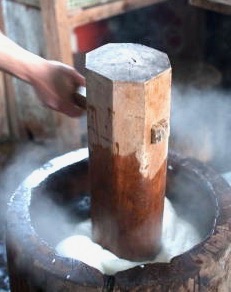
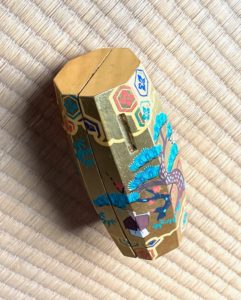
Mochi is made by pounding it with kine, 杵, mallet of wood, with an off-set handle so that the mallet does not need to be turned to maintain its downward alignment. The form of the kine is often round, but there are some that are octagonal in section. The wooden kine in the above photograph has 8 sides to impart the concept of Infinity in Space, radiating outward in all directions.
The name, buri-buri, is usually written in hira-gana, ぶりぶり, which is for reading only. However, buri-buri, can be written with the Kanji, 振々, wield-‘ditto’, that is the action associated with swinging the mallet head. Perhaps the reason for only having the pronunciation of the word, allows for interpretation and wordplay on buri, 振, swing, shake, wave, swing, pretense, appearance, dance move, counter for swords, throw, jilt, etc.
In Chanoyu, the kine mallet head is copied and cut in half to form a kō-gō, 香合, incense-gather, that is decorated with auspicious motifs for the New Year. The form of the kō-gō shown in the picture is tapered at both ends, which indicates that it has been used has been worn down. It, theoretically, has been used to make mochi for the gods and others, but the kōgō was made new.
In addition, there is a very popular food fish called hamachi, 魬, also 鰤, yellowtail, amberjack, a species of yellowtail, Seriola quinqueradiata. When the fish matures, and becomes quite plump, around the age of 4 years, it is called a buri, and it is this full rounded stage of development that identifies it with the buri-buri mallet head. This fish, that has many names, when prepared in a special way of grilling with soy sauce, becomes the very tasty dish named buri no teri-yaki, ぶりの照り焼き, plump (yellowtail) ’s bright-fired. The buri dish is also served and eaten to celebrate a departure, and the fish was formerly given as a year-end gift. This may be the particular connection to the buri-buri mallet head kōgō of the New Year.
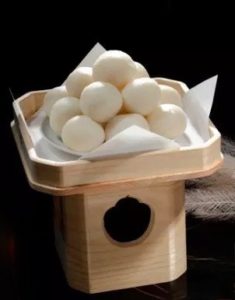
Perhaps the balls, and at times pinecones, being hit by the mallet of the buri-buri are mochi balls being hit out into the world. After the festivities of the New Year, the various festival ornaments are gathered together, burned, and their smoke rising to heaven. The fire is built on a tripod made of gitchō mallets, which do not burn entirely, and form the three gitchō pieces of charcoal shita-bi, 下火, down-fire, in the ro. 炉, hearth.

